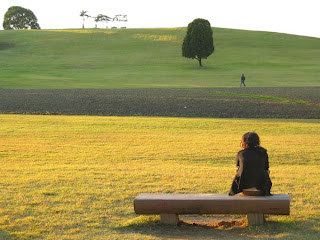Parks in Seoul. Over the past few years theGovernment of Seoul have been implementing a five year plan for green growth. This means they will be using and promoting Eco products, using less fossil fuels and promoting green environments such as parks for it’s residents and tourists. The Cheonggyecheon river was part of this project and also the World Cup Parks.
There are hundreds of parks in Seoul with around 40 major ones. These are great for relaxing and getting out of the house. Some of the parks are huge and have a whole range of activities. Along the Han River alone there are 12 parks called the Hangang Parks
Here is a list of some parks located in Seoul with detailed information, maps, directions and photos.
Olympic Park
Covering over 1.5 million square meters and the ancient site of the Mongchon Toseong Fortress (with its moat dating back to the early Baekche Kingdom), Olympic Park preserves the spirit of the 1988 Seoul Olympics. The stadiums, arranged in a fan-shaped pattern around the park, were the main stages for the sports events. With extensive grassy fields, sculpture gardens, walking paths, and rest areas, the park is open all day as a multi-purpose area for leisure, sports, and cultural activities.
Transportation:
Subways:
Jamsil (Jamsil Stadium)-Seoul Line 2 (green) , Seoul Line 8 (pink)
Mongchon Toseong (World Peace gate)- Seoul Line 8 (pink)
Olympic Gongwon (Olympic Park)- Seoul Line 5 (purple) Machon branch
jamsilnaru- Seoul Line 2 (green)
Seoul Forest Park
Olympic Park
Covering over 1.5 million square meters and the ancient site of the Mongchon Toseong Fortress (with its moat dating back to the early Baekche Kingdom), Olympic Park preserves the spirit of the 1988 Seoul Olympics. The stadiums, arranged in a fan-shaped pattern around the park, were the main stages for the sports events. With extensive grassy fields, sculpture gardens, walking paths, and rest areas, the park is open all day as a multi-purpose area for leisure, sports, and cultural activities.
Transportation:
Subways:
Jamsil (Jamsil Stadium)-
Mongchon Toseong (World Peace gate)- Seoul Line 8 (pink)
Olympic Gongwon (Olympic Park)- Seoul Line 5 (purple) Machon branch
jamsilnaru- Seoul Line 2 (green)
Seoul Forest Park
| ntroduction | ||||||
| Opened on June 18, 2005, Seoul Forest had previously undergone a series of changes on Ttukseom (Ttuk Island). In the past the forest had been a royal hunting ground for kings and served as a military inspection facility. But, in more recent decades the area has served a wide variety of functions. Ttukseom initially served as a water-treatment facility, and later as a golf course, horse racing track, and eventually a sports park. Consisting of five parks spread over 350,000 pyeong (approximately 1.16 million ㎡) of land, Seoul Forest is an eco-friendly zone appreciated not only by the people of the city but also those visiting Seoul. Seoul Forest is rapidly developing into the premium city-park of Korea like Hyde Park in London and Central Park in New York. * Cultural Art Park (220,000㎡) Situated in the heart of Seoul Forest, the Cultural Art Park features Seoul Forest Square, Ttukseom Family Field, decorative flower beds, a visitors’ center, a skate park, an outdoor stage, a waterside lounge (restaurant), an in-forest open space, an in-forest play ground and a water play area. * Ecological Forest (165,000㎡) The Ecological Forest, once an area covered by the Han River, has been transformed into an eco-forest connecting the Han and Jungnang-cheon (Jungnang stream). This natural habitat for wildlife animals is home to fallow deer, formosan deer, elks, chipmunks, mandarin ducks, mallards, spot-billed ducks and moorhens, there is also an observatory to help visitors get a better view of the local wildlife. * Nature Experiencing Study Field (85,000㎡) Occupying the structure of the former Ttukseom Water Treatment Facility, this refurbished educational area was established to house an insect botanical garden, a wild flower garden, a themed flower garden, an event ground and a surrounding protective forest. * Wetlands Ecological Field (70,000㎡) Making use of the local reservoir’s natural environment, the Wetlands Ecological Field contains a wetlands ecological management office, an ecological playground, an outdoor nature classroom, a bird observatory, a wetlands flower garden and a botanical garden fed with local, clear waters. * Han River Waterside Park (33,000㎡) Located southwest of Seoul Forest, this riverside area at the junction of the Han River and Jungnang-cheon features a waterfront park, a marina and a rest area.  
|
| Directions |
| From exit #1 of World Cup Stadium station (Seoul Subway Line 6), cross the street and walk 3 - 5 min toward Mapo Agriculture-Fisheries Market. At the right of the building, take the free shuttle (20 min interval). * The bus stop is blocked by the Mapo Agriculture-Fisheries Market building. |





















0 comments:
Post a Comment